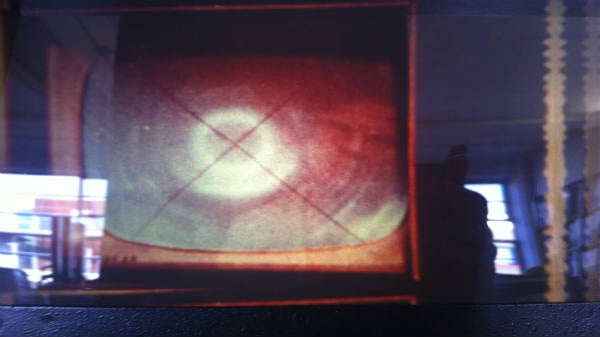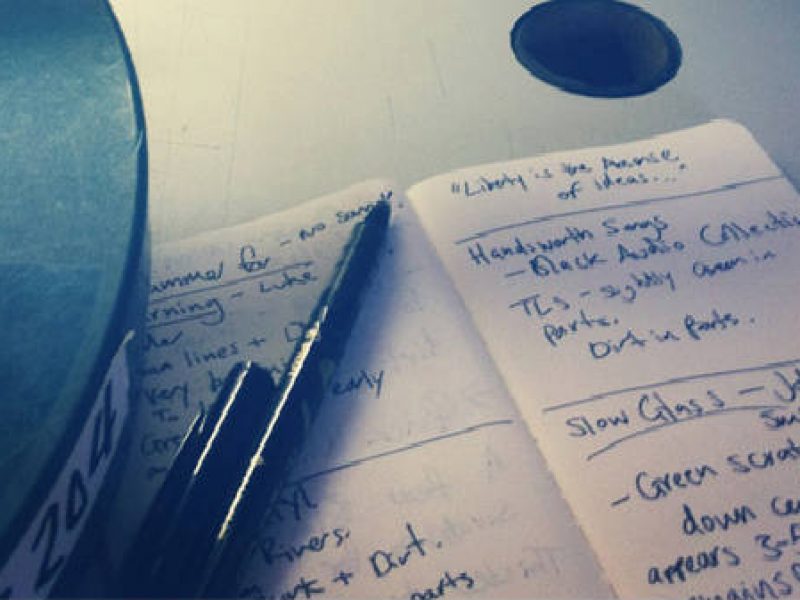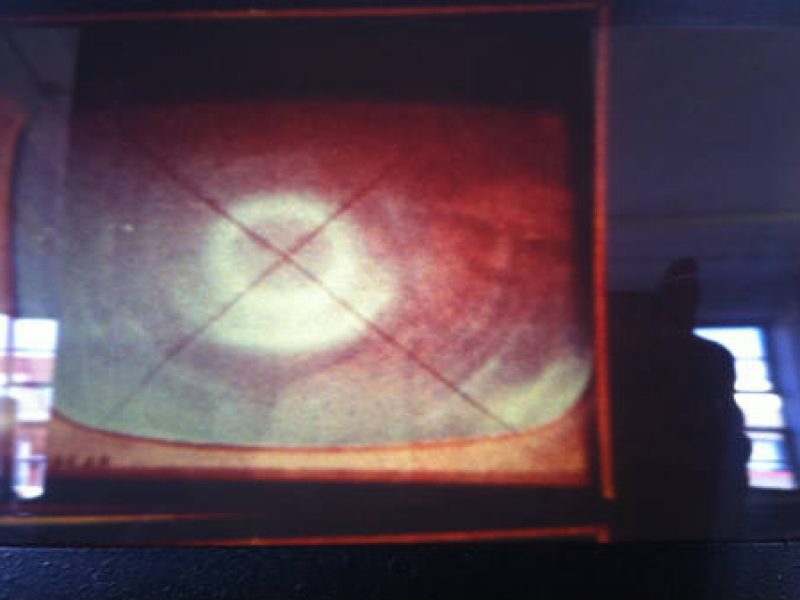A container is selected from the archive based firstly on its level of importance distinguished by its position on the shelves and secondly on the name upon it. This is taken to the projector where its lid is removed. Taped to the inside lid is a paper slip; notes from previous checks. Alongside each description is a reference number; a breadcrumb of the film’s journey, each of these numbers refer to the last institution to which this film was loaned. Without the proper database it is not possible to ascertain to whom these films have been previously loaned, unless one is familiar with the numbers, the institutions and the database. Sometimes there is a projectionist note. Most of the time there isn’t.
Where am I?
I first read the artist’s name on a tin and the accompanying title, then check the duration and making sure it fits in with my schedule and how much time I am able to spend here, then follows my decision: I select the film for checking. The rarely present projectionist’s instructions is taped inside this container, drawing awareness to another state of viewing, something removed from my setting.
The projectionist’s instructions are clearly written, but I’m not fully sure I understand. “Top screen electronically induced seizure. Bottom screen photically induced seizure”. The words suggest that this film as it sits here is incomplete; that in order for it to become complete a specific set of rules must be followed and in order to follow these rules a second film must be played simultaneously. By watching this film as it is, I am defying these rules and therefore I start to doubt whether what I am viewing in its current state is art. It then occurs to me that artist films (and artworks) are always accompanied by a set of viewing rules, these rules are not always spoken but are taken for granted and are generally suggested and adhered to based on surroundings, typically an institutional setting, and an accompanying text. But my settings and the rules I have to follow differ somewhat; does this detract from the piece or is there a different way, a new way to perceive a piece that is perhaps unique to very few?
Where is it?
The screen is no bigger than 15cm x 30cm and sets the film’s white tones in the yellowish tone of the bulb. The film’s intensity unravels and flickers between blue and pink and distorted facial expressions akin to the ghouls of modern day horrors and my mind wonders to that space I have created elsewhere, where I am enclosed with these images: one sat on top of the other, unable to focus on both simultaneously, unable to escape the voluminous acousmatic groans and grotesque features of the face and I attempt to enforce the potential affect of such a film. I move my head closer to the screen using my hands as blinkers either side of my eyes and try feebly to recreate that space. The image fills my visual periphery, the flashing, the faces, then the warping of the film travelling across the top of the screen; the heavy TLs and dirt. I return to an upright position on my chair and take notes. Y314 (4).
What is missing?
The verb is in the title; it suggests the audience should listen, the title is an instruction, it makes you aware of the act of listening so how can one do anything else? This is what I do. Immediately a paradox occurs as the sound track hisses and jumps to the rhythm of static attaching itself to the film. Is this what I am supposed to be listening to? Silence according to the medium? Listen, listen. A burning match and a hiss, hiss.
This machine reads the picture and noise through the same source: light. It is called optical sound and features a visualisation of the soundtrack, as waves, to the right of the screen. There is no visualisation accompanying the sound in my earphones. Optical sound must be working in conjunction with the static to form a sort of optical noise: the external to but a part of the film; creating a soundtrack which correlates not with the image as such, but with the grain which comprises a total image – the journey, the mark.
The medium of this film implies that image and sound are as one; the volume switch on the RTI applies to light as well as the sound, yet this film keeps its soundtrack separate, as if the two were never meant to be conjoined, but are some how incidental. The projectionist’s instructions give a cue as to when to set off a digital soundtrack. Digital, barely deteriorating in quality overtime: static free, clean, a stark contrast to this image which is delicate in its 16mm form. It leads me to imagine that this speculative aural clarity would deliver a certain amount of tension. If the artist were to collaborate with machine then could what I am hearing be one potential result?
T714 (2) promises a way of listening as appropriate to the image. I never got to hear the sound. Part 1 was long, parts 2 and 3 of this film are not checked by me.
What is left?
Words are intended to add something to the image, the film; whether a title, a review, an artist statement. Context too has a role to play in adding meaning. Does this mean in this environment something new can be learned or said for the piece, that it is still an “art” but one in pieces, or removed? Can a piece transcend meaning dependent on context? If so then the context of the film must determine how it is to be read as separate from its original purpose. Here I am only able to talk of the film in terms of two things: 1. What is missing; what is taken away from the whole of the film in terms of image, quality and sound. 2. What is added to the film, in terms of journey and the mark of the other. All that I can determine for sure, is a level of damage signified by a rating, a simple number.
Mandi Goodier is an artist and writer currently checking the films at LUX, as well as writing somewhere between fiction, theory and biography; about repetition, memory, the mark and otherness. Twitter: @mandigoodier






